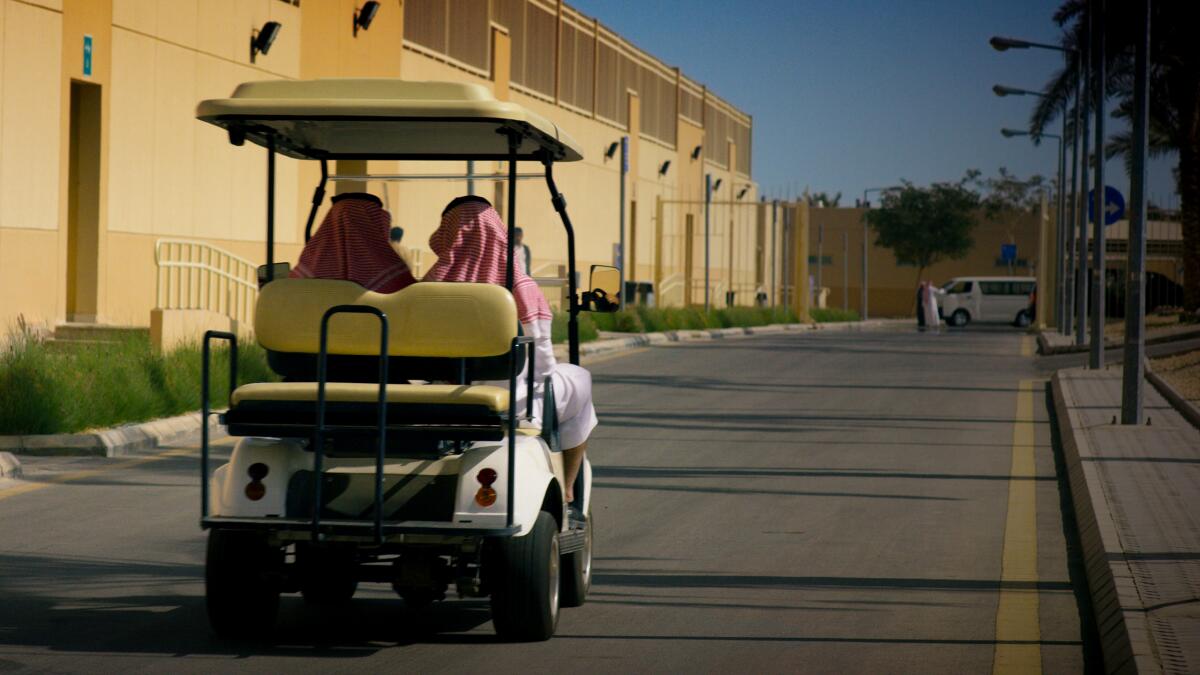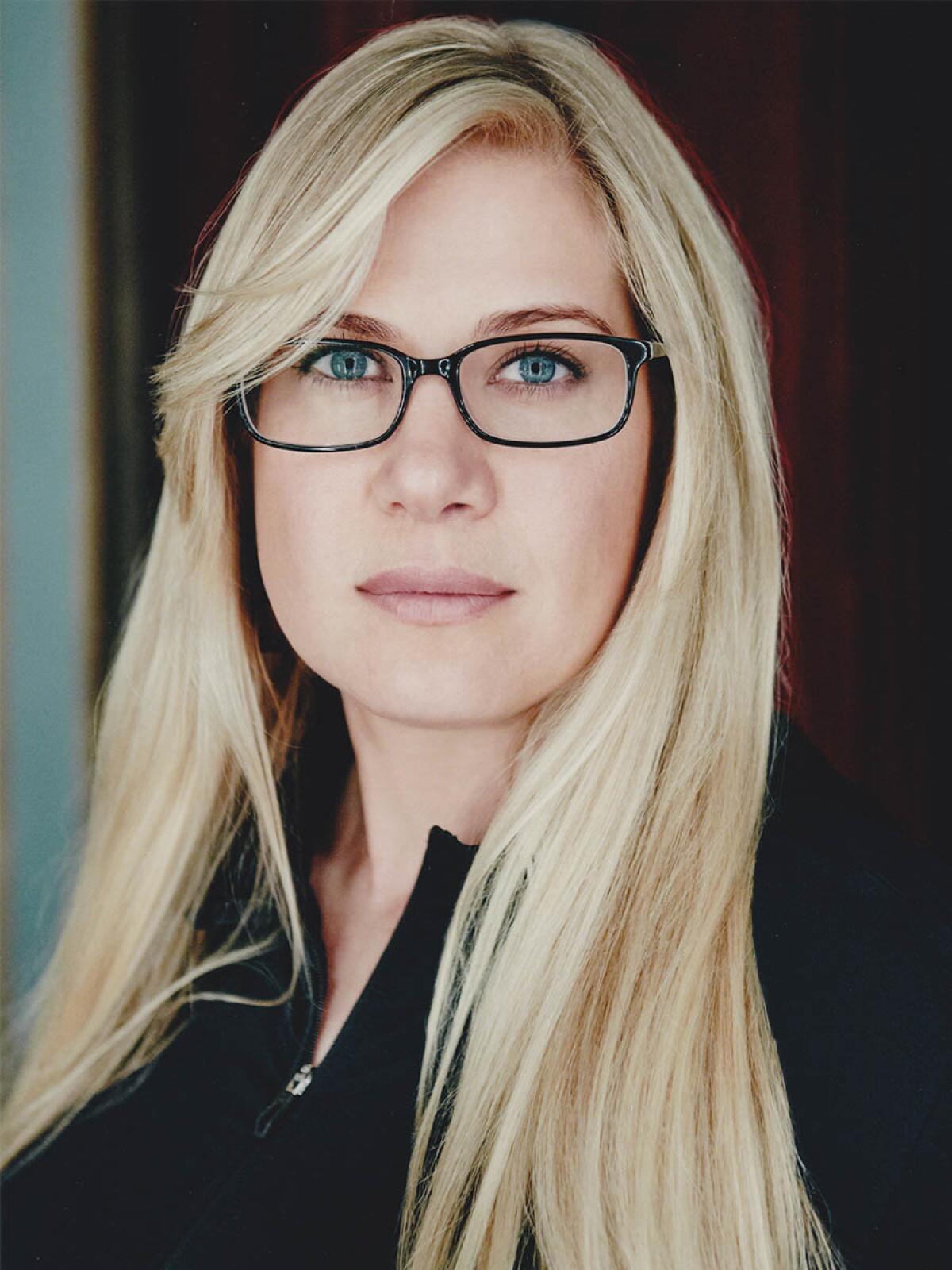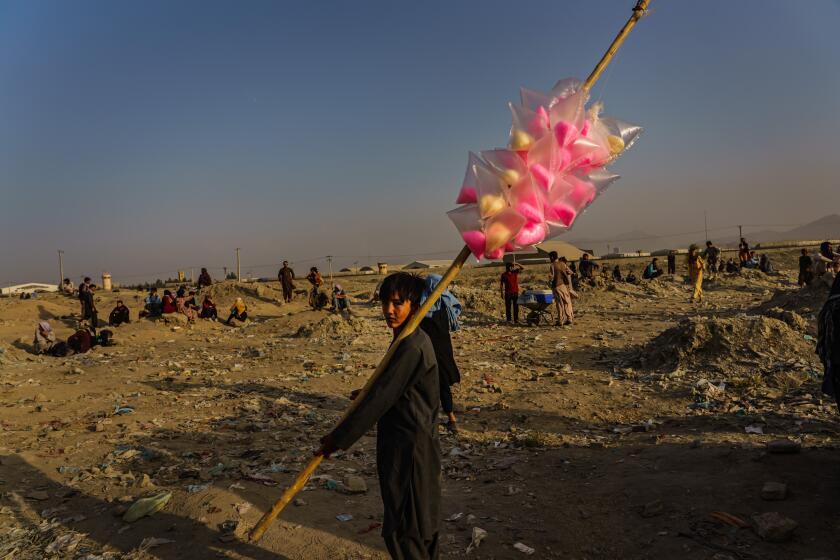‘Jihad Rehab’ started a furor at Sundance. But the problem is bigger than one film

- Share via
The documentary “Jihad Rehab,” despite its questionable title, has the sort of premise that’s usually innocuous to indie film buffs. The film follows three men, each of whom were detained for 15 years at the U.S. naval base at Guantanamo Bay, after their transfer to a “rehabilitation” facility in Saudi Arabia for former terrorism suspects. It’s a humanizing journey through a complex emotional process of self-reckoning and accountability, and a look at the devastating fallout of flawed U.S. and Saudi policy as the men are reconditioned from radicalization and warfare to polite society.
So I was confused to learn recently of the controversy around the film’s inclusion in this year’s Sundance Film Festival, which has since provoked an official apology from the organization. All at the behest not of Islamophobes but of Muslims.
I’m Muslim, and I like “Jihad Rehab.” (Cue the pile-on.) But more importantly, I wanted to understand how Muslim filmmakers’ objections to the still-undistributed doc, organized into a social media campaign, spiraled into the latest firestorm over authorship and representation. And how it left longtime supporters of free expression like the Sundance Institute suddenly on the side of censorship.
Ramy Youssef and Mahershala Ali discuss Season 2 of Hulu series “Ramy” and Hollywood’s long neglect of Muslim stories and characters.
There are far more egregious, laughable and dangerous depictions of Muslims and Middle Easterners out there to challenge, after all. Tie on a blindfold and throw a dart at a list of 21st century movies and you’ll hit a gross misrepresentation: “The Hurt Locker,” “American Sniper,” “Wonder Woman 1984.” We’ve been handy villains, victims and dispensable sidekicks. But “Jihad Rehab” is not that kind of film. Arguably, it counters many of those tropes.
The documentary chronicles the trials and friendships of its Yemeni subjects after their transfer from the hell of Guantanamo to the relative calm of the Mohammed bin Nayef Counseling and Care Center in Riyadh. To become eligible for release, they are to complete a yearlong program and pass a “threat” assessment — and even then they cannot return home. Instead, they’ll live under monitoring in Saudi Arabia, prohibited from seeing each other ever again.
Director Meg Smaker follows the trio over three years, and the film features regular sit-down interviews, visits to their classes — life skills, coping with PTSD, social etiquette — and animated sequences that illustrate their frequent bouts of PTSD and anxiety over the events in their past and the uncertainty that lies ahead. The men speak in detail about imprisonment at Guantanamo, but it’s left ambiguous whether they were truly “terrorists,” as the U.S. and Saudi Arabia label them, individuals merely adjacent to Al Qaeda, or something else entirely. Whatever their backgrounds before imprisonment, their testimonials reflect the reality of their surveilled circumstances: They are a mix of defensive and guarded, honest and pained, and tellingly transparent when listing the progress they’ve made for off-camera handlers.

As the political landscape shifts, so do their fortunes. After Crown Prince Mohammed bin Salman seizes power in 2017, the filmmaker is denied access and the men languish as they languished in Guantanamo, all while Yemen’s humanitarian crisis, perpetuated by a Saudi-led military campaign, threatens their families. Smaker, who’s lived in Yemen and Saudi Arabia, continues to follow up as the program falls apart, including after the men’s release, when they’re isolated from their homeland and trapped by laws that forbid them to work in a country they cannot leave. The film emerges as a moving portrait of souls damaged and destroyed by war, largely anonymous figures caught up in the tangle of a decadeslong conflict. And before the controversy broke, many reviewers agreed.
But some independent Muslim filmmakers felt differently. They argued that the film started from a presumption of guilt — that the men were portrayed as terrorists though they’d never been formally charged with a crime. They suggested that Smaker should have had more Muslims involved in decision-making positions on the film. And they alleged that her methods put her interview subjects in danger.
It makes sense that Muslims would be skeptical of yet another film about Muslims set against the backdrop of the so-called war on terror. And the concerns raised about the title are not easily dismissed. But the issue at the core of the “Jihad Rehab” maelstrom is not so much the text of the film as the fact that it was made by a white, non-Muslim filmmaker and arrived at a moment in which the debate over who is allowed to tell whose story was already at a boiling point.
It may be the stickiest argument in culture today: After hundreds of years’ worth of misrepresentation, creators of color and other artists from marginalized groups have rightfully begun to demand ownership of their own narratives, correcting a history of their peoples being viewed through a white lens. High-profile projects to have come under criticism have included the novel “American Dirt,” called out by Latino groups; Ken Burns’ documentary “The Vietnam War,” challenged by Vietnamese filmmakers; and Sia’s movie “Music,” which ignited the autism community. Their projects had merit, but their one-sided view or appropriation of history, immigration needed to be challenged — and that never would have happened if those works were killed off before they even arrived. The debates sparked by such moments are certainly part of how we will get through this, not over it.
The question now is how to move forward promoting authenticity in authorship without siloing diverse filmmakers, petrifying conflict-avoidant gatekeepers and eating each other alive. There are no rules or guidelines in place for the rabbit hole of possibilities broader representation opens. Can a South Asian man tell a South Asian woman’s story? Should a Shia spin a Sunni narrative? If a white filmmaker teams up with Indigenous creatives, is it progress or tokenism? The answer: It’s complicated.
But ultimately there’s a difference between vociferously criticizing a film — a key part of culture-making — and stifling its exhibition, as some opponents of “Jihad Rehab” have sought to do. (Some have even claimed that proponents of the film are patronizing for even suggesting it’s humanizing or empathetic, which borders on an ad hominem attack.) A film losing its shot at an audience over such a controversy doesn’t encourage critical thinking about images of Muslims. It throttles it.
From ‘Shock and Awe’ to the death of Bin Laden, U.S. networks treated the war as a distant spectacle. Overseas, it was brutally, frightfully close.
The fight over “Jihad Rehab” has diverted attention from the unquestionable problem here — the lack of representation of Muslim filmmakers at Sundance and other major festivals — to single out a film seen, to this point, by vanishingly few people. The festival’s own flat-footedness hasn’t helped matters; to display provocative work, as is its mission, requires sustained engagement with stakeholders long before, and after, the lights go down. Now two Sundance staffers have resigned in protest, the festival has issued an apology and just about everyone is unhappy. In expressing regret over the hurt caused by the screening of the film, festival leaders wrote that they had a responsibility “to balance freedom of creative expression and support for contentious and thought-provoking work with the assurance that it is presented with proper context and space for debate, and to maintain, and where necessary evolve, a curatorial process that upholds our mission and values.”
As someone who has spent a career fighting for MENA representation, it’s important to me that our legitimate grievances about authorship and representation be taken seriously. But it’s also important for more people to see a thought-provoking, admittedly imperfect film like “Jihad Rehab” — and judge its authorship and representation for themselves.
There is room for both, and there is always room for improvement.
More to Read
Only good movies
Get the Indie Focus newsletter, Mark Olsen's weekly guide to the world of cinema.
You may occasionally receive promotional content from the Los Angeles Times.












